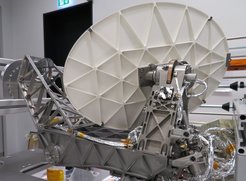JUICE: Next Steps until Launch
ESA's space probe is on the move: First it heads for the launch site in Kourou - and in April it will begin its long journey to Jupiter and its icy moons.
Approximately three months before embarking on its eight-year-long trek to the Jupiter system, ESA's spacecraft Jupiter Icy Moons Explorer (JUICE) faces a shorter - and much more terrestrial - journey in the coming weeks. In early February, the probe will set off from Toulouse (France) to its South American launch site in Kourou (French Guiana). Already today, JUICE was officially bid farewell at the Airbus premises in Toulouse - and with it the Submillimeter Wave Instrument (SWI), which was developed and built under the leadership of the Max Planck Institute for Solar System Research (MPS) in Göttingen (Germany), as well as the Particle Environment Package (PEP), to which the MPS contributed. Once in the Jupiter system, both instruments will help explore the gas giant and its large, potentially life-friendly moons in greater detail than ever before. Currently, the science and engineering teams at MPS are preparing for the instrument commissioning in the weeks and months following launch.

Still three weeks until JUICE travels to the launch site; about three months until JUICE launches into space; eight years until JUICE reaches its destination, the Jupiter system.... What sounds like a long, long wait for the scientists involved is actually a countdown. Despite the fact, that the instruments and sensors contributed to the mission by the MPS have already left Göttingen in 2021 and 2020 and have long since taken their place on board the JUICE spacecraft, the JUICE teams at MPS currently have a busy schedule.
"We are already preparing for the first measurements in space, testing software and simulating different operating modes," explains MPS scientist Dr. Paul Hartogh, Principal Investigator of SWI. These activities also involve the flight spare units, the identical twins of the instruments that remain on the ground as a reference. After all, the space instruments will turned on well before 2031, when they arrive in the Jupiter system. "The first milestone is the commissioning of the instruments in the weeks and months after launch," says MPS scientist Dr. Norbert Krupp from the PEP team. It will take several months before step by step each of the ten JUICE instruments is permitted to show that it also functions smoothly under space conditions.
A tenfold view of Jupiter's icy moons

JUICE is not the first mission to explore Jupiter and some of its moons from close range, but with a total of ten instruments, the probe carries the most comprehensive instrumentation ever used in the outer solar system. Another difference to previous missions such as Juno and Galileo: JUICE will focus its attention on the large, ice-covered moons Europa, Ganymede, and Callisto. SWI, for example, will among other things study the atmospheres of Jupiter and the icy moons and take a close look at the thermophysical properties of their ice crusts. To this end, the spectrometer will study the thermic radiation that these bodies emit into space. The PEP instrument package, for which the scientific and technical teams at MPS developed and built the Jovian Electron and Ion Sensor (PEP-JEI), measures the energetic charged particles in the environment of the gas giant and its moons. Among other things, this allows conclusions about the formation of the Jupiter system.

One of the most exciting questions the researchers hope to answer is whether the moons Europa, Ganymede, and Callisto are habitable. Do they really harbor liquid oceans hidden beneath their thick ice crusts, as measurements from earlier missions suggest? Jupiter's strong tidal forces, which virtually churn the moons' interiors, could provide the necessary heat. From Jupiter's moon Europa, fountains of water are known to escape into space through cracks and trenches in the ice crust.
Ganymede has even more exciting qualities. With a diameter of more than 5260 kilometers, it is not only the largest moon in the Solar System, but even dwarfs the innermost planet Mercury. It is the only known satellite to generate its own magnetic field, and measurements by the Hubble Space Telescope even indicate a very thin atmosphere of oxygen and hydrogen. After several flybys of Europa, Ganymede, and Callisto, JUICE will therefore enter into orbit around the giant moon toward the end of the mission.

"Ganymede, Europa, and Callisto almost seem like a planets in their own right and probably offers a few of the conditions necessary for the emergence of life," says MPS Director Prof. Dr. Thorsten Kleine, head of the Department of Planetary Sciences.
From Europa to South America - and from there into space
Before JUICE actually encounters Ganymed, however, many years will pass. First, JUICE has to be transported from Airbus in Toulouse (France), where it has undergone its final tests in recent months, to the launch site: In early February, the spacecraft will embark on its transatlantic journey by air to ESA's Guiana Space Center in French Guiana. The launch is scheduled for April.















